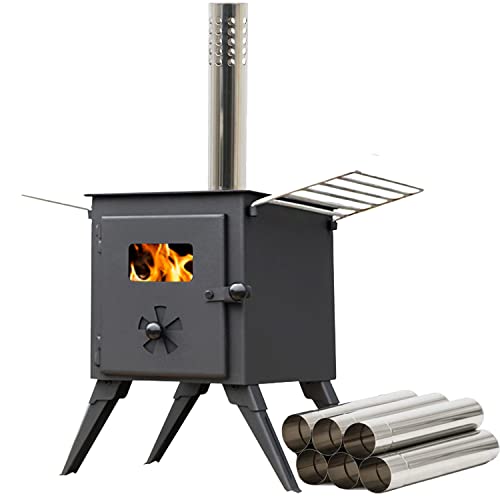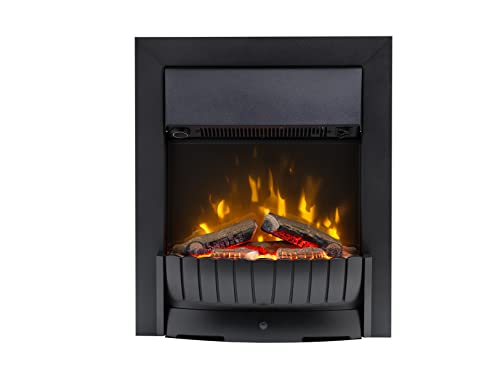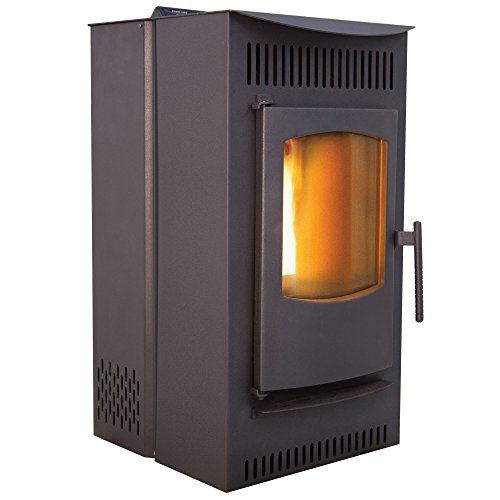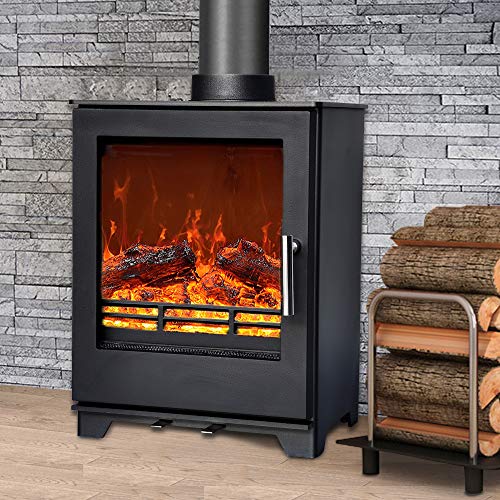The Wood Fire Stove Success Story You'll Never Believe
Adding a Wood Fire Stove to Your Home
A wood-fired stove is an excellent source of heat for your home. The majority of modern stoves are easy to operate and clean.
The air that fuels the flame is drawn in by the adjustable dampers on the stove's door. The exhaust gases are taken up the chimney and safely released from the building. The combustion process creates plenty of heat and carbon monoxide gases, which are air pollutants.
Warmth
A wood burning stove for sale (Related Web Page) stove can be a great alternative heat source for your home. This type of heating not only can add style to a space but also is cost-effective. Many models are available in various styles to compliment any style.
When using a wood fire stove it is important to remember that a properly maintained and properly burning fire requires oxygen to burn. Therefore, it is essential to keep combustible materials like books, paper, clothing and furniture away from the stove. In general keep combustible items at least three feet away from the stove.
In addition, when lighting the fire it is recommended to start with smaller pieces of wood. The larger logs can smother your fire, causing creosote and smoke to build up. It is also recommended to monitor the flow of air as the fire progresses. Most stoves have levers which can be adjusted to control the flow of air and stop the fire from burning too fast. Once the fire is established it is best to gradually reduce the air flow.
It is also best to stay clear of using fuel accelerants like gasoline, oil, or kerosene when starting the fire. These substances could cause an explosion inside the stove and also speed up the combustion of wood, and release toxic gases into your home.
When you are deciding where to put your wood stove, it's best to place it in a central area of your home. This will help ensure that the warm air produced by the stove is distributed evenly across the home. It is also a good idea to position the stove in a way that it is not too close to a staircase. Warm air tends to rise, so when the stove is placed too close to a staircase, it will lose a lot of its warmth to the floor above.
It is essential to be aware of local laws that pertain to smoke. Some areas have been designated as smoke control zones and it is unlawful to release smoke from a stove or fireplace.
Savings
A wood fire stove can provide plenty of heat for a fraction of the cost of gas or electricity. A rough estimate is that one kilowatt hour of energy can be produced from a wood stove for around a fifth of the price of a kWh generated by electricity and about a third of the cost of a kWh from gas.
Wood is not only cheap, but it is also an energy source that is renewable and much better for the planet than fossil fuels such as gas or oil. The wood used in a stove has been absorbed by tree as it grew, which means burning it doesn't release any carbon dioxide into the atmosphere. Wood can also be sourced from sustainable sources, where trees are planted for every one that is felled, making it an energy source that is carbon-neutral.
Another benefit of a wood stove is that it can be used to cook, as well as providing warmth. A stove with an oven built-in can be a great option for any kitchen. It can be used to bake, roast or braise food items. This will reduce the need to go out for meals. It also gives the feeling of being at home.
Watching the flames dance in a fireplace is an incredibly relaxing and warm experience. It's also a great opportunity to bond with family and friends. Sitting with a drink in front of the fire is a romantic experience and a great opportunity to wind down after a long and tiring day.
Make sure that the stove you pick is the correct size for the space you want to heat. A stove that is too small will not heat the room effectively and will waste money. It is best to consult with experts who have experience in sizing and installing stoves. It is also important to avoid opening the door of the wood stove too often as this will let heat escape, which will slow the combustion process. This could also cause smoke in the room which is harmful to health.
Eco-friendly
Wood fire stoves aren't only green in terms of energy savings and efficiency, but also due to their impact on the environment. Wood burning produces less harmful pollutants than other fossils fuels like coal or oil that are known to cause respiratory issues and heart ailments. These pollutants, referred to as particulate matter (PM) are tiny particles that can enter the lungs, causing long-term health problems.
There are wood stoves on the market which emit less harmful pollutants and are more efficient than previous models. It is essential to use the stove in a safe manner and select the best one to prevent the release of excessive PM into the air. It is also essential to install carbon monoxide detectors in the rooms where a stove is in use and to ensure that chimneys are regularly cleaned.
The stove will emit less PM when you burn logs that have been kiln dried and seasoned. This is because the dryer the logs are, the quicker and more efficiently they will burn. It is also a good idea to buy logs locally from a sustainable source. This will support local businesses.
You can also reduce the PM emissions by only using a wood stove only when the room is not in use. If you leave it running for a long period of time, it will generate excessive heat, which can result in an excess of PMs to be released into the atmosphere.
Although wood stoves are an excellent way to stay warm and reduce heating costs however, they are not always the greenest choice for an urban setting. This is because burning wood releases the carbon dioxide that the tree consumed when growing, which would not be absorbent by the trees in urban areas to create a carbon neutral.
Fun
Consider getting one of these fans if want to make your wood-log burning stoves stove more fun. They distribute heat throughout your home. You'll feel more comfortable and you will save money on fuel. They also look cool and add an interesting design to your fireplace. There are a variety of types of wood stoves available, but it is important to pick one that is long-lasting and comes with a top quality. Some models require batteries or cords, while others are self-powered and will start when the temperature reaches an optimum temperature.
A high-quality wood stove fan will have a noise level of less than 25 decibels and a smooth operation. To ensure durability it is recommended to clean it periodically by dusting and then pouring oil onto the blade shatter. In addition to that it should be kept at a safe distance from the flames so as not to get burned.
 Another option is the Galafire N429, which can be used with wood or gas stoves. It has an impressive airflow rate that can reach 440 feet per minute. It is lightweight and cost-effective and has a simple-to-clean design. It features a thermoelectric conversion that converts heat to electricity. This lets you save 12 percent on fuel expenses.
Another option is the Galafire N429, which can be used with wood or gas stoves. It has an impressive airflow rate that can reach 440 feet per minute. It is lightweight and cost-effective and has a simple-to-clean design. It features a thermoelectric conversion that converts heat to electricity. This lets you save 12 percent on fuel expenses.
When choosing a wood stove, select the one with a higher CFM rating. This means that the fan can effectively spread air throughout the room. The best models will have more than two four" blades and be made from higher-quality materials. They can also be made out of stainless steel or anodized aluminum to ward off corrosion and rust.
Some fans can even give you an indication of the effectiveness of your fire. The Ecofan Ultrair is a fantastic example of this, since it will let you know if the fire is burning at high or low temperature. It has a special patented design and has been scientifically tested. It will also notify you when more logs are needed to provide fuel to the fire. It's an excellent option for wood stove owners who are looking to maximize their efficiency.
A wood-fired stove is an excellent source of heat for your home. The majority of modern stoves are easy to operate and clean.
The air that fuels the flame is drawn in by the adjustable dampers on the stove's door. The exhaust gases are taken up the chimney and safely released from the building. The combustion process creates plenty of heat and carbon monoxide gases, which are air pollutants.
Warmth
A wood burning stove for sale (Related Web Page) stove can be a great alternative heat source for your home. This type of heating not only can add style to a space but also is cost-effective. Many models are available in various styles to compliment any style.
When using a wood fire stove it is important to remember that a properly maintained and properly burning fire requires oxygen to burn. Therefore, it is essential to keep combustible materials like books, paper, clothing and furniture away from the stove. In general keep combustible items at least three feet away from the stove.
In addition, when lighting the fire it is recommended to start with smaller pieces of wood. The larger logs can smother your fire, causing creosote and smoke to build up. It is also recommended to monitor the flow of air as the fire progresses. Most stoves have levers which can be adjusted to control the flow of air and stop the fire from burning too fast. Once the fire is established it is best to gradually reduce the air flow.
It is also best to stay clear of using fuel accelerants like gasoline, oil, or kerosene when starting the fire. These substances could cause an explosion inside the stove and also speed up the combustion of wood, and release toxic gases into your home.
When you are deciding where to put your wood stove, it's best to place it in a central area of your home. This will help ensure that the warm air produced by the stove is distributed evenly across the home. It is also a good idea to position the stove in a way that it is not too close to a staircase. Warm air tends to rise, so when the stove is placed too close to a staircase, it will lose a lot of its warmth to the floor above.
It is essential to be aware of local laws that pertain to smoke. Some areas have been designated as smoke control zones and it is unlawful to release smoke from a stove or fireplace.
Savings
A wood fire stove can provide plenty of heat for a fraction of the cost of gas or electricity. A rough estimate is that one kilowatt hour of energy can be produced from a wood stove for around a fifth of the price of a kWh generated by electricity and about a third of the cost of a kWh from gas.
Wood is not only cheap, but it is also an energy source that is renewable and much better for the planet than fossil fuels such as gas or oil. The wood used in a stove has been absorbed by tree as it grew, which means burning it doesn't release any carbon dioxide into the atmosphere. Wood can also be sourced from sustainable sources, where trees are planted for every one that is felled, making it an energy source that is carbon-neutral.
Another benefit of a wood stove is that it can be used to cook, as well as providing warmth. A stove with an oven built-in can be a great option for any kitchen. It can be used to bake, roast or braise food items. This will reduce the need to go out for meals. It also gives the feeling of being at home.
Watching the flames dance in a fireplace is an incredibly relaxing and warm experience. It's also a great opportunity to bond with family and friends. Sitting with a drink in front of the fire is a romantic experience and a great opportunity to wind down after a long and tiring day.
Make sure that the stove you pick is the correct size for the space you want to heat. A stove that is too small will not heat the room effectively and will waste money. It is best to consult with experts who have experience in sizing and installing stoves. It is also important to avoid opening the door of the wood stove too often as this will let heat escape, which will slow the combustion process. This could also cause smoke in the room which is harmful to health.
Eco-friendly
Wood fire stoves aren't only green in terms of energy savings and efficiency, but also due to their impact on the environment. Wood burning produces less harmful pollutants than other fossils fuels like coal or oil that are known to cause respiratory issues and heart ailments. These pollutants, referred to as particulate matter (PM) are tiny particles that can enter the lungs, causing long-term health problems.
There are wood stoves on the market which emit less harmful pollutants and are more efficient than previous models. It is essential to use the stove in a safe manner and select the best one to prevent the release of excessive PM into the air. It is also essential to install carbon monoxide detectors in the rooms where a stove is in use and to ensure that chimneys are regularly cleaned.
The stove will emit less PM when you burn logs that have been kiln dried and seasoned. This is because the dryer the logs are, the quicker and more efficiently they will burn. It is also a good idea to buy logs locally from a sustainable source. This will support local businesses.
You can also reduce the PM emissions by only using a wood stove only when the room is not in use. If you leave it running for a long period of time, it will generate excessive heat, which can result in an excess of PMs to be released into the atmosphere.
Although wood stoves are an excellent way to stay warm and reduce heating costs however, they are not always the greenest choice for an urban setting. This is because burning wood releases the carbon dioxide that the tree consumed when growing, which would not be absorbent by the trees in urban areas to create a carbon neutral.
Fun
Consider getting one of these fans if want to make your wood-log burning stoves stove more fun. They distribute heat throughout your home. You'll feel more comfortable and you will save money on fuel. They also look cool and add an interesting design to your fireplace. There are a variety of types of wood stoves available, but it is important to pick one that is long-lasting and comes with a top quality. Some models require batteries or cords, while others are self-powered and will start when the temperature reaches an optimum temperature.
A high-quality wood stove fan will have a noise level of less than 25 decibels and a smooth operation. To ensure durability it is recommended to clean it periodically by dusting and then pouring oil onto the blade shatter. In addition to that it should be kept at a safe distance from the flames so as not to get burned.
 Another option is the Galafire N429, which can be used with wood or gas stoves. It has an impressive airflow rate that can reach 440 feet per minute. It is lightweight and cost-effective and has a simple-to-clean design. It features a thermoelectric conversion that converts heat to electricity. This lets you save 12 percent on fuel expenses.
Another option is the Galafire N429, which can be used with wood or gas stoves. It has an impressive airflow rate that can reach 440 feet per minute. It is lightweight and cost-effective and has a simple-to-clean design. It features a thermoelectric conversion that converts heat to electricity. This lets you save 12 percent on fuel expenses.When choosing a wood stove, select the one with a higher CFM rating. This means that the fan can effectively spread air throughout the room. The best models will have more than two four" blades and be made from higher-quality materials. They can also be made out of stainless steel or anodized aluminum to ward off corrosion and rust.
Some fans can even give you an indication of the effectiveness of your fire. The Ecofan Ultrair is a fantastic example of this, since it will let you know if the fire is burning at high or low temperature. It has a special patented design and has been scientifically tested. It will also notify you when more logs are needed to provide fuel to the fire. It's an excellent option for wood stove owners who are looking to maximize their efficiency.


 Multi Fuel Stoves
Multi Fuel Stoves The ashes then fall into an ash pan below which needs to be regularly emptied. Most
The ashes then fall into an ash pan below which needs to be regularly emptied. Most 
 A wood stove is a stove made of solid fuel that burns wood or wood pellets for fuel. It usually consists of a closed firebox made of metal and an air control system. Modern wood stoves generally employ secondary combustion processes to increase efficiency. This process utilizes catalyst converters to reburn partially-combusted gases in the flue. The process of combustion also reduces smoke levels and air pollution from the stove by reducing the temperature at which the fuel is burned. The result is an improved energy yield from the fuel and less ash to clean after every use.
A wood stove is a stove made of solid fuel that burns wood or wood pellets for fuel. It usually consists of a closed firebox made of metal and an air control system. Modern wood stoves generally employ secondary combustion processes to increase efficiency. This process utilizes catalyst converters to reburn partially-combusted gases in the flue. The process of combustion also reduces smoke levels and air pollution from the stove by reducing the temperature at which the fuel is burned. The result is an improved energy yield from the fuel and less ash to clean after every use.